Scam Awareness or Fraud Awareness

At Walgreens, we prioritize the security and privacy of our customers. This page provides helpful information to protect yourself from fraud and scams. If you’ve encountered a suspicious message, call, or offer that uses the Walgreens name or logo, we encourage you to report it. You’ll find contact details to notify Walgreens directly or file a report with the appropriate government agency.
FAQ
- Safety Tips
- Be wary of unsolicited contact. Treat emails, texts, or calls you don’t expect (especially those asking for personal or financial data) with extreme caution.
- Avoid interacting with unknown senders. Don’t reply to or click links in messages from unfamiliar sources unless you can independently verify them.
- Confirm identity before sharing anything sensitive. If you are asked for personal information, payment data, or login information, confirm who is requesting it using a trusted channel.
- Do not open unexpected attachments or links. Even if they appear legitimate, these could contain malware or redirect you to fraudulent sites.
- Do not buy items from unsolicited messages. Phishing scams often feature “free” offers or deals you never asked for.
- Never send payment to someone you cannot verify. Especially avoid wire transfers or gift cards requested by unverified individuals.
- Research unfamiliar contacts. Use search engines to investigate the situation, email address, or phone number before taking any action.
- Verify company communications independently. If you're unsure whether a message is truly from a company, visit their official website and use the contact information listed there. Do not use phone numbers or links provided in the suspicious message.
- Inspect email addresses and URLs carefully. Scammers often create fake domains that closely resemble legitimate ones.
- Hover over links to preview URLs. If the actual URL doesn’t match the displayed text, do not click it.
- Do not deposit suspicious checks. If you're asked to deposit a check and send money back, it's likely a scam. Fake checks can take weeks to be identified, and you’ll be liable for any losses.
- Monitor your financial accounts regularly. Review your statements for unauthorized transactions and report any suspicious activity to your bank or account provider immediately.
- Gift Card & Money Transfer Scams
Scams involving gift cards and money transfers come in many forms, but they all share a common goal: to create a false sense of urgency or legitimacy that convinces victims to send money. Below are some of the most frequent tactics used:
Emergency Scam
A scammer poses as a loved one—or someone claiming to represent them—in an urgent situation requiring immediate financial help. Common scenarios include bail payments, medical emergencies, or travel issues. These scams often target older adults and may involve impersonation of a grandchild or an authority figure such as a police officer, doctor, or attorney.
IRS Scam
The scammer pretends to be an IRS agent, threatening arrest or legal action over alleged unpaid taxes. Victims are pressured to pay immediately using gift cards or money transfers to avoid severe consequences.
Online Seller Scam
Typically occurring on resale or marketplace platforms (e.g., Craigslist, OfferUp), the scammer lists an item at an attractive price and requests payment via gift cards or money transfer. Once payment is made, the scammer disappears, leaving the buyer without the item or any way to recover their money.
If you’ve been scammed using gift cards purchased at Walgreens, please contact us at 1-877-865-9130. Be prepared to provide a copy of your purchase receipt and images of the front and back of the gift card(s).
We will work with our gift card processor and the third-party issuer to attempt to recover available funds on the cards. Please note that if account numbers and PINs were disclosed to an outside party and a card’s balance has been depleted, we will not be able to return any funds back to you. Due to the high volume of reports, resolution may take up to 12 weeks.
Tips to Avoid Gift Card & Money Transfer Payment Scams
- Be wary of unusual payment requests. Scammers prefer gift cards and money transfers because they’re difficult to trace and recover. Legitimate businesses and government agencies will never ask for payment this way.
- Use secure platforms for online purchases. Pay through official websites (e.g., Etsy) or trusted services like PayPal, which offer buyer protection and refund options.
- Watch for social engineering tactics. Fraudsters may use social media to gather personal details to make their story more convincing.
- Pause and verify before acting. Scammers rely on urgency and fear to pressure victims. Take time to research, reflect, and consult with someone you trust before making any decisions.
- Phishing Emails
Phishing emails are crafted to trick recipients into clicking on links that lead to fraudulent websites designed to look legitimate. These sites may prompt you to “log in” using your credentials, which scammers then use to access your real accounts. You may also be asked to provide personal or financial information, putting you at risk for identity theft, financial loss, or future security breaches. In some cases, the website may contain malicious code, or the email itself may include attachments that install malware on your device.
Like caller ID spoofing, phishing emails may misuse the Walgreens name or logo to appear authentic. However, emails officially from Walgreens will only come from the following domains:
- @walgreens.com
- @eml.walgreens.com
- @ecs.walgreens.com
- @rxorder.walgreens.com
- @e.walgreens.com
The example below shows the sender’s email address is one not authentically belonging to Walgreens.

Phishing Email Red Flags
- The sender’s email domain does not match the company it claims to represent, or it slightly varies from the legitimate domain.
- The company name appears in the username portion of the email address (e.g., walgreens123@gmail.com).
- Embedded links do not match the display text—hover over links to preview the actual URL.
- Claims of winning a contest or being approved for something you never entered or applied for.
- Unknown or suspicious email addresses are cc’d on the message.
- Offers of free gifts that require payment for fees, taxes, or shipping.
- Generic greetings such as “Dear Shopper” or “Greetings” instead of your name.
- A strong sense of urgency or threats designed to pressure you into acting quickly.
- Spelling mistakes, grammatical errors, or awkward phrasing.
- Unsolicited attachments with instructions urging to open them.
Examples of Phishing Emails Impersonating Walgreens
Prize or Gift Card Giveaway
These emails claim they are offering a free gift as part of a giveaway. Walgreens does not offer these types of promotions, and we do not contact our customers through unsolicited email campaigns.
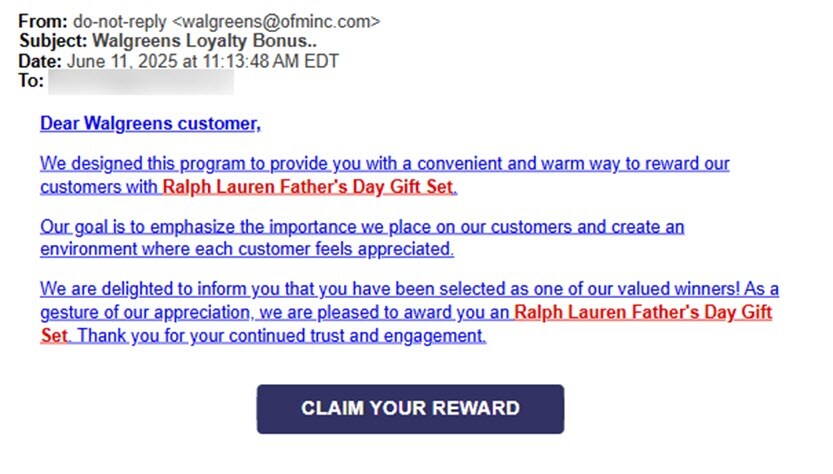
Reward for Completing a Survey
These emails are like the previous example except they claim they will send a gift in exchange for completing a survey.
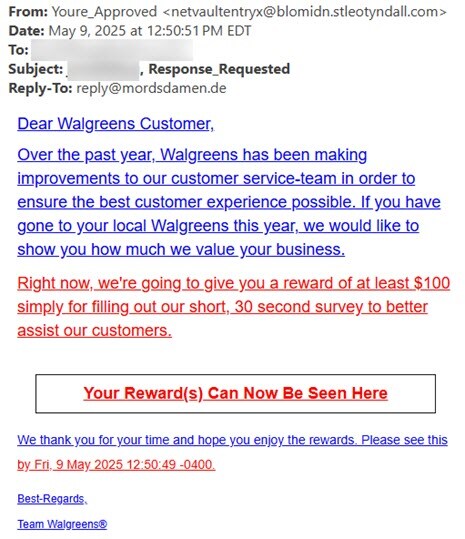
Customer survey requests that are legitimately from Walgreens are offered at the bottom of an in-store purchase receipt or sent from the email address Walgreens@eml.walgreens.com to customers who recently placed an order on Walgreens.com. If you receive a survey request via email that states it’s from Walgreens and you didn’t recently make an online purchase or it offers anything in return for participating in the survey, you should delete it.
Loyalty Cash Rewards Expiring
Walgreens may inform myWalgreens loyalty members when their rewards are expiring, however the below example is not from a legitimate Walgreens email address and Walgreens will never require you to take action to claim rewards.
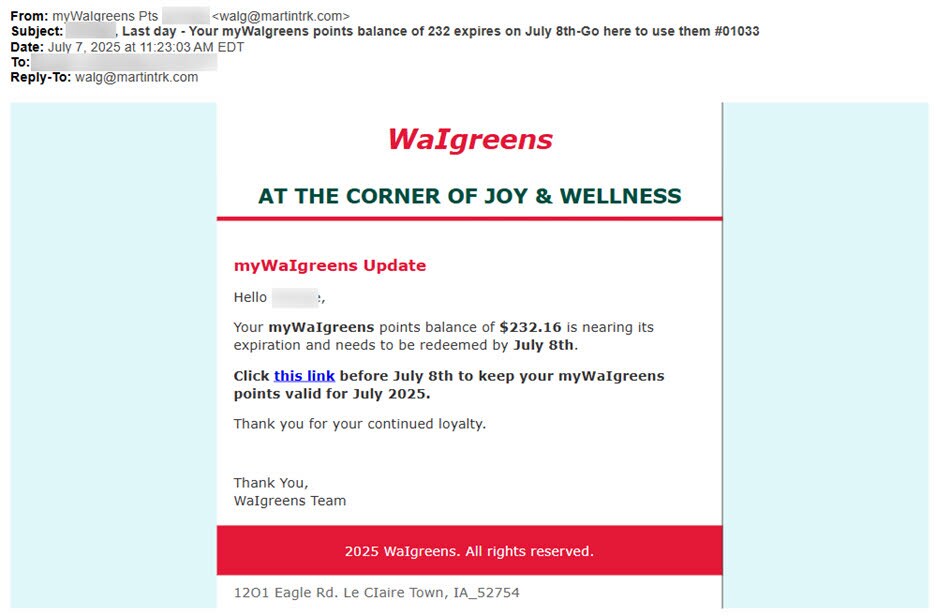
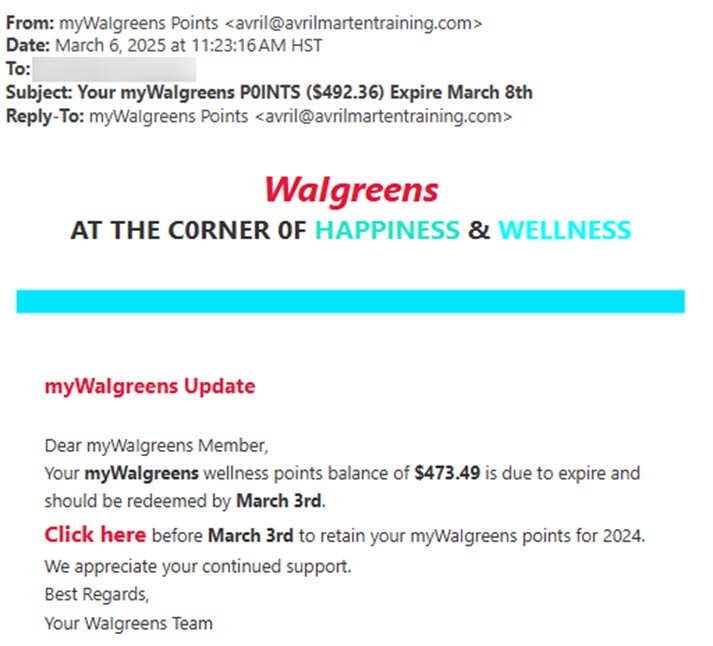
Order Confirmation or In-Store Purchase Receipt
You will only receive an order confirmation or purchase receipt email if you completed an order on Walgreens.com or are opted into digital receipts for in-store purchases through myWalgreens. If you did not place an order or recently make an in-store purchase and aren’t opted into digital receipts, the email is a scam; the perpetrators are expecting you to be concerned and click on a link in the email without considering its legitimacy. If you would like to see if an order was placed using your account, login directly using the Walgreens app or on Walgreens.com.
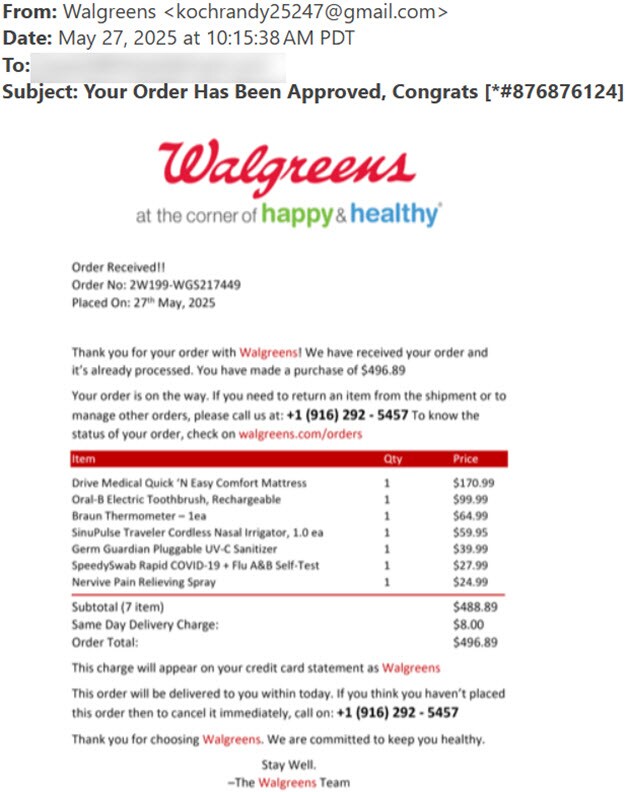
Password Reset
Password reset emails are only legitimate if you initiated the process on Walgreens.com or the Walgreens app. If you did not initiate the password reset, the email is a scam. To review a list of devices recently used to access your account, visit the Security Information page.
How to Report Phishing Emails
- To report it directly to Walgreens, forward the email to report-fraud@walgreens.com.
- To report it to the Federal Trade Commission (FTC), forward the email to spam@uce.gov or visit their website.
- To report it to the Anti-Phishing Working Group (APWG), forward the email to reportphishing@apwg.org or visit their website.
- SMS (Text Message) Phishing
Like its email-based counterpart, text message phishing (usually referred to as SMS (Short Message System) phishing or “smishing”) uses social engineering tactics to gain access to private information. It may also use Walgreens’ name or logo to appear more legitimate.
While most communications from Walgreens are sent through email, customers can opt-in to receive important pharmacy and order updates via text message (e.g., prescription or order status). However, we will never request personal, financial, or account information; if you receive something asking for this type of information, you can be confident it didn’t come from Walgreens.
SMS Phishing Examples
The following are examples of phishing texts purporting to be from or affiliated with Walgreens. These are
not legitimate communications from Walgreens, and recipients should not open links, disclose personal information, or respond.Prize or Gift Card Giveaway
Messages of this sort claim they are offering a free prize as part of a giveaway. Walgreens does not participate in these types of promotions, and we do not contact our customers through unsolicited text message campaigns.
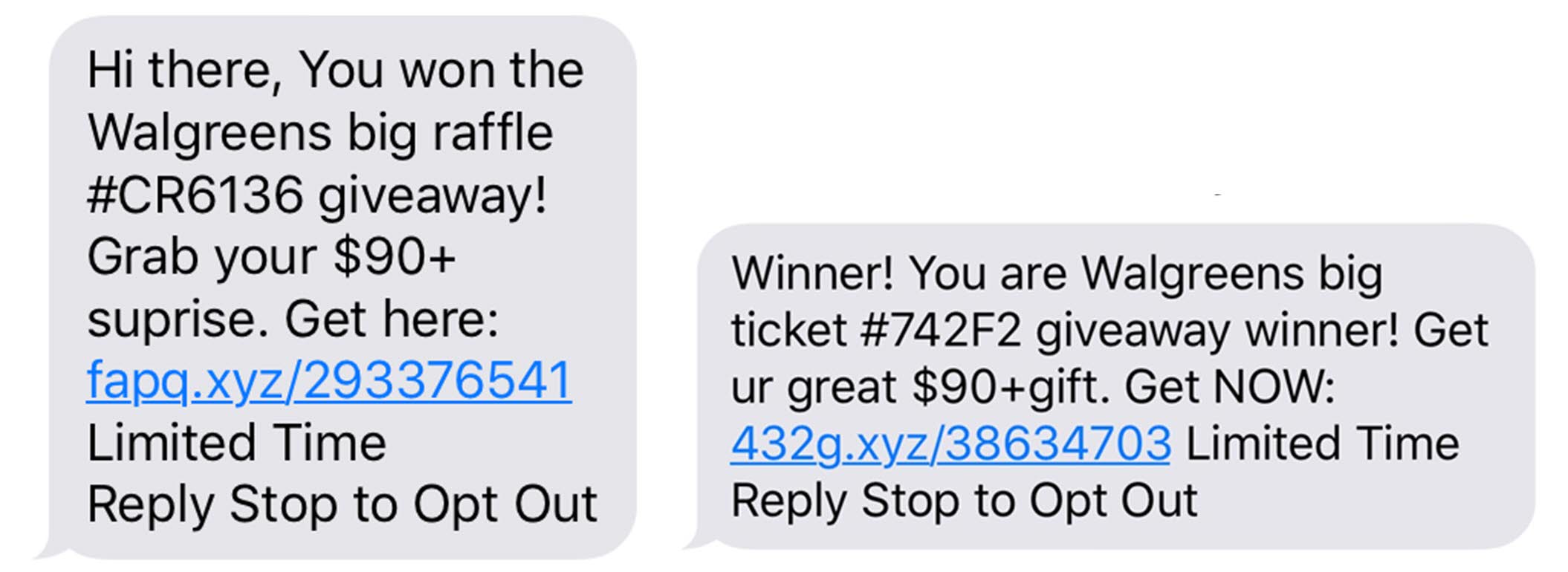
Reward for Completing a Survey
Like the previous example, these messages claim they will send a gift in exchange for completing a survey. Customer survey requests that are validly from Walgreens are offered at the bottom of an in-store purchase receipt or sent via email to customers who recently placed an order on Walgreens.com.
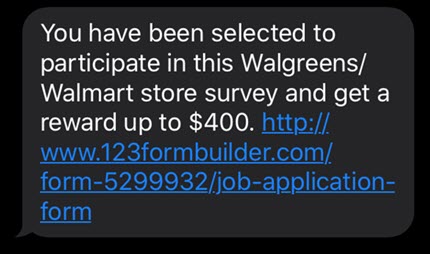
Order Confirmation
If you place an order on Walgreens.com, an order confirmation and receipt will be sent to you electronically via email and never in a text. If you receive this type of message, you shouldn’t open any links or respond and delete it immediately. The perpetrators are expecting you to be concerned and click on a link without considering its legitimacy.
If you would like to see if an order was placed using your account, sign in directly using the Walgreens App or on Walgreens.com.

- Mystery Shopping Scams
A mystery shopper is someone hired to evaluate a business’s customer experience by posing as a regular shopper. While legitimate mystery shopping programs do exist, Walgreens does not participate in or sponsor any mystery shopper programs. Any offer claiming to be a Walgreens mystery shopper opportunity is fraudulent and should be treated as a scam.
Scammers typically send unsolicited emails advertising a mystery shopper position and include a link to an application form. Once the victim provides personal information, they receive a follow-up message stating they’ve been selected for the role and should expect a check in the mail.
The check is presented as reimbursement for purchases made as part of the assignment and compensation for the job. Victims are instructed to visit a store, purchase gift cards, and send images of the cards with the PINs scratched off. Once the scammers receive the gift card information, they disappear.
A few days later, the victim’s bank notifies them that the check was counterfeit. Because banks are required to make deposited funds available quickly—but may take weeks to detect a fake check—the victim is left responsible for repaying the full amount, often after the funds have already been spent.
If you receive an email or text message offering a mystery shopping position with Walgreens, avoid responding or clicking embedded links and immediately delete it.
Mystery Shopper Scam Email Examples
The following are examples of scam emails advertising fake mystery shopping positions with Walgreens. These are not legitimate job offers.
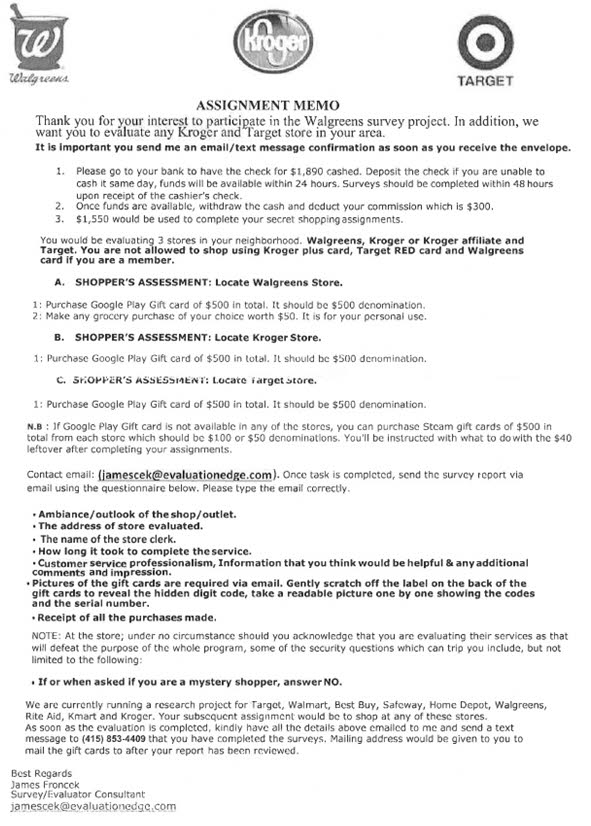
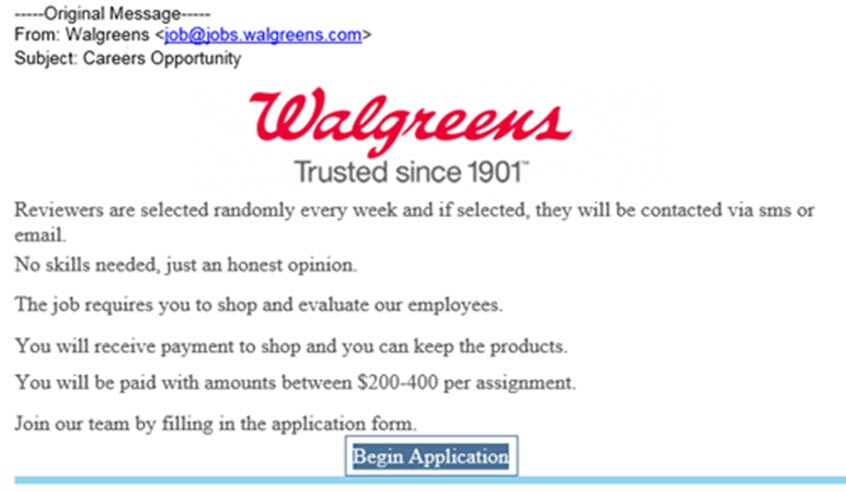
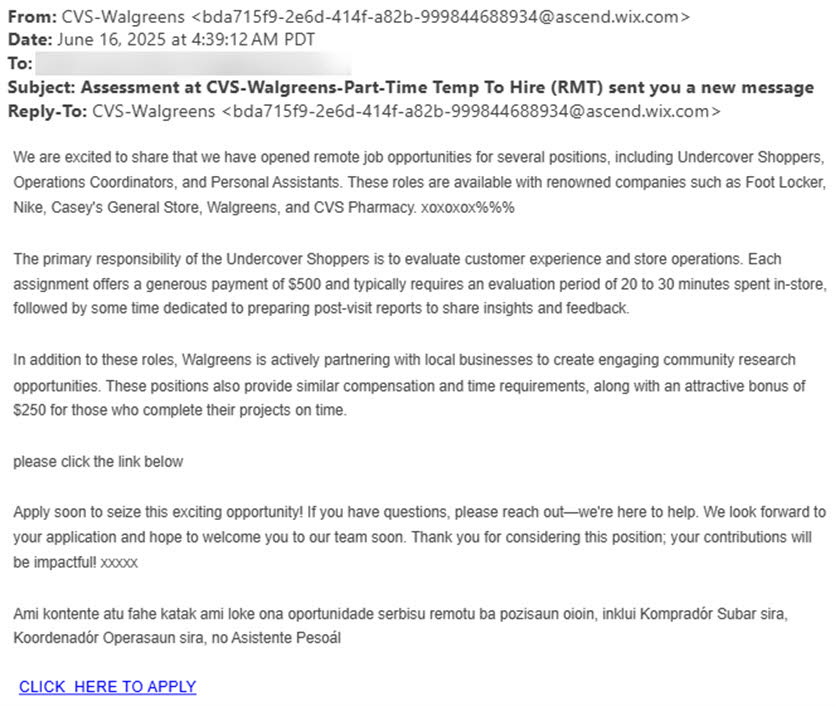
- Employment & Recruitment Scams
Scammers are increasingly targeting job seekers in an effort to steal personal information or trick victims into sending money. These scams often involve individuals posing as representatives of legitimate companies—such as Walgreens—and may even impersonate real employees, including executives from Human Resources. This tactic is designed to build trust: if a potential victim searches the name of the supposed contact and finds a real employee at the company, they may be more likely to comply with the scammer’s requests.
One common version of this scam involves sending the victim a counterfeit check, allegedly to cover training or equipment expenses. After the check is deposited and the funds appear available, the scammer claims there was an overpayment and asks the victim to return a portion of the money. Because banks are legally required to make deposited funds available quickly—but may take weeks to identify a fake check—the victim often ends up responsible for repaying the full amount once the check is found to be fraudulent.
Other reported scams include the use of fake Walgreens email addresses and interviews conducted through social media or instant messaging platforms such as Yahoo Messenger or Google Hangouts. Walgreens does not use these services for recruitment and will never ask for payment related to job applications, training, or equipment.
If you are concerned that recruitment activity or an offer of employment with Walgreens might be a scam, please verify by searching for the posting on our Careers website or email corporate.careers@walgreens.com to report the incident.
Employment & Recruitment Scam Red Flags
- Job positing is for a generic position (e.g., administrative assistant) and the description is vague.
- Payment for employment is given prior to work being completed.
- You are not asked to complete an I-9 form or other pre-employment paperwork when hired for the position. Federal law requires U.S. employers to have this completed for every individual they recruit, refer for a fee, or hire for employment in the United States and legitimate companies will not proceed with the hiring process without this being done.
- Caller ID Spoofing
Caller ID spoofing is the practice of deliberately falsifying the phone number or name that appears on a recipient’s caller ID. This tactic is often used by scammers to make their calls appear as though they are coming from a trusted source.
The Federal Communications Commission (FCC) prohibits the use of caller ID spoofing when it is intended to defraud, cause harm, or wrongfully obtain anything of value.
To make their scams more convincing, fraudsters may spoof a Walgreens phone number, making it seem as though the call is coming from a legitimate Walgreens location or department. Walgreens is not affiliated with this type of activity, and any such call should be treated with caution.
If you suspect you were contacted by a spoofed number:
- File a complaint with the FCC over the phone (1-888-225-5322) or online.
- File a report with your local police department.
- To report it to the Anti-Phishing Working Group (APWG), forward the email to reportphishing@apwg.org or visit their website.
- If financial information was given, immediately contact your bank.
- Medical Record Request Scams
Scammers have been targeting doctors’ offices with fraudulent faxes or letters that falsely claim to be from Walgreens’ Medical Records Department. These communications request patient medical records under the pretense of “updating files.” They often include a name and title—such as a supposed Manager of the Records Department—along with a phone and fax number for submitting the requested information.
To appear more credible, these scams may misuse Walgreens’ name or logo and reference legitimate organizations like the National Association of Boards of Pharmacy (NABP). However, Walgreens is not affiliated with these requests, and they should be treated as fraudulent.
While Walgreens may contact providers to obtain patient information for Medicare Part B billing purposes, legitimate requests will:
- Be specific and clearly related to the items being billed.
- Contain complete and accurate information.
- Be professionally formatted with correct grammar and punctuation.
If you are a provider and suspect a request for patient medical records may be fraudulent, please contact Walgreens for verification at 1-877-378-9787 (Monday – Friday, 8 AM – 4:30 PM CST).
Medical Record Request Scam Red Flags
- Generic or vague requests without stating specific information needed or the purpose of the request.
- Uneven or misaligned logos and text.
- Other retailer or organization logos with the Walgreens logo.
- Scanned signature for individuals claiming to be from Walgreens’ Records Department.
- Designates a pharmacy not used by the patient.
- Incorrect patient information or misspellings.
Medical Record Request Scam Example
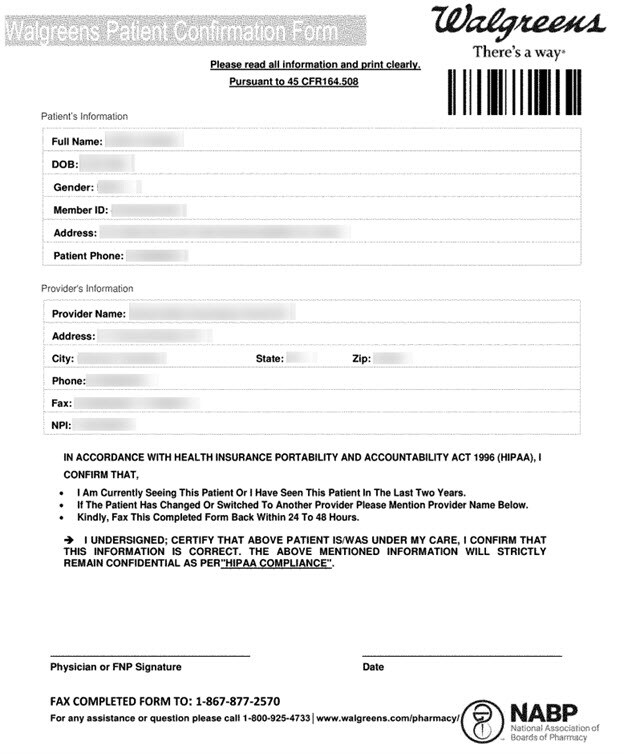
- Additional Resources
Federal Trade Commission (FTC)
Internal Revenue Service (IRS)
Better Business Bureau (BBB)
FBI Internet Crime Complaint Center (IC3)
